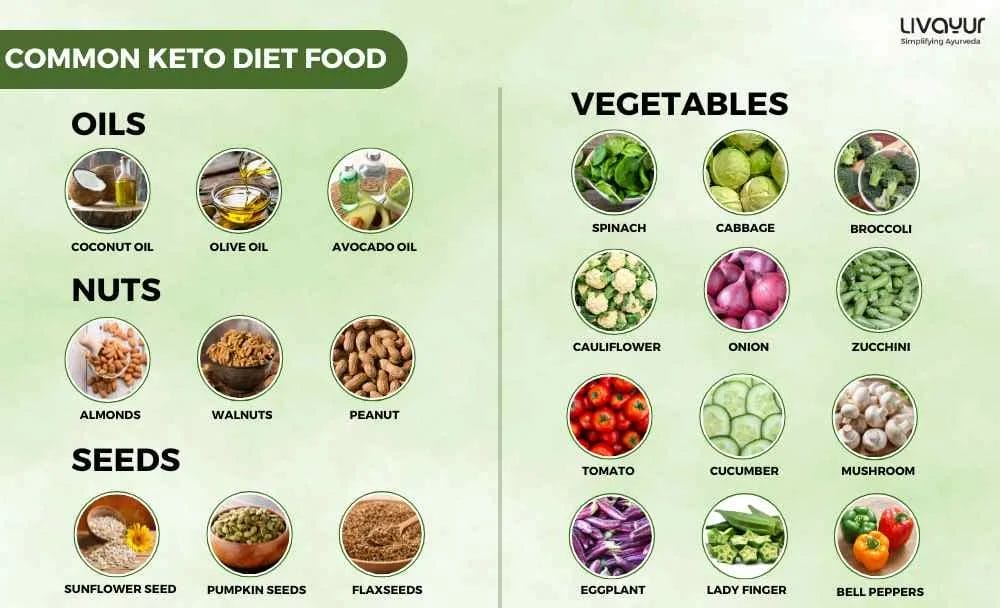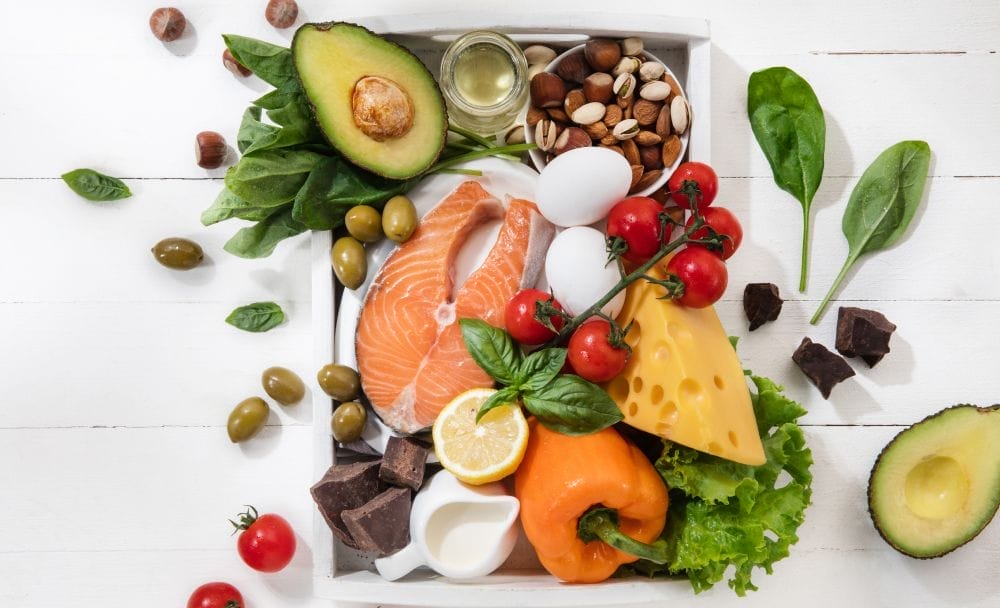
With concerns of overweight issues and obesity on the rise all over the globe, the Ketogenic Diet, or Keto Diet, has gained much popularity in recent years as a powerful and effective approach to weight loss and overall health improvement. To answer what is keto diet, this dietary regimen emphasizes consuming high-fat, moderate protein, and low-carbohydrate foods, ultimately leading the body to produce and use ketones as an energy source. During this metabolic state of ketosis, the body primarily burns the fat deposits for fuel instead of carbohydrates. [1] This comprehensive A-Z guide will provide an in-depth exploration of the Keto Diet, covering everything from what is keto diet, its fundamental principles to practical tips for success.
Advantages of the Keto Diet
Keto diet weight loss:
The primary reason many individuals adopt the Keto Diet is its ability to promote weight loss. By reducing carbohydrate intake and increasing fat consumption, the body switches to reducing the overall calorie intake, resulting in efficient Keto diet weight loss. [3]
Increased Energy intake and expenditure:
As the body adapts to using fat as its main energy source, many people experience increased energy levels. [3]
Appetite Control:
The Keto Diet can help regulate appetite and reduce food cravings due to its high-fat and moderate-protein content. It leads to decreased hunger as the body tends to feel fuller leading to better portion control and reduced snacking. [3]
Basic Principles of the Keto Diet

Macronutrient Composition:
The Keto Diet consists of high fat, moderate protein, and low carb intake. Typically, it involves consuming approximately 70-75% of daily calories from fat, 20-25% from protein, and only 5-10% from carbohydrates. [1]
Carbohydrate Restriction:
The key principle of the Keto Diet is minimizing carbohydrate intake to induce ketosis. This means avoiding or limiting high-carbohydrate food intake to less than 50g per day. This causes the insulin secretion to be significantly reduced causing the body to enter a catabolic state. It also causes the glycogen stores to deplete, compelling your body to go through certain metabolic changes. [2]
Healthy Fat Sources:
Healthy fats play a crucial role in the Keto Diet as a source of energy intake. [2] Replacing carbohydrates with fat results in greater energy expenditure. This is basically induced because of the changes in levels of catecholamines and thyroid hormones that affect energy expenditure in individuals on a ketogenic diet. [3]
Adequate Protein:
While the Keto Diet is high in fat, it’s important to consume moderate amounts of protein to maintain body mass. [2] This also increases the thermogenic effect of protein and the lipolysis of fatty tissue due to reduced insulin levels, thus increasing fatty acid oxidation. [3]
Common Keto Diet Food List Include
Healthy Fats:
Common keto diet foods include coconut oil, olive oil, avocado oil, nuts (almonds, walnuts, peanut, pistachio), seeds (flax seed, sunflower seed, pumpkin seed), and seafood (Tuna, shrimp, sardines).
Non-Starchy Vegetables:
vegetarian keto diet foods include leafy greens (spinach, cabbage), broccoli, cauliflower, onion, zucchini, tomato, cucumber, bell peppers, mushroom, eggplant, lady’s finger.
Protein Sources:
Other keto diet foods are lean meats (chicken, beef), eggs, bacon, and pork.
Dairy and Dairy Alternatives:
Full-fat dairy products (cheese, Greek yogurt), unsweetened nut milk (almond, coconut), paneer, heavy cream, mayonnaise, and butter can form great keto diet plan veg.
Fruits:
Strawberries, blackberries, raspberries, watermelon, avocado, and olive are also great vegetarian keto diet foods. [1]
Types of Ketogenic Diet

When it comes to the Keto Diet, there are several variations or types that individuals can choose to follow based on their specific needs and preferences. Here are some of the popular types of Keto Diets:
Standard Ketogenic Diet (SKD):
The Standard Ketogenic Diet is the most common and well-known version of the Keto Diet. It involves consuming very low-carbohydrate, moderate-protein, and high-fat foods. The macronutrient distribution is usually around 70-75% fat, 2o% protein, and 5-10% carbohydrates.
Cyclical Ketogenic Diet (CKD):
The Cyclical Ketogenic Diet involves alternating periods of strict ketosis with higher-carbohydrate refeeding days. For example, following a standard keto diet for five to six days and then having one or two higher-carb days.
Targeted Ketogenic Diet (TKD):
The Targeted Ketogenic Diet allows for a small amount of carbohydrates to be consumed during physical workouts. Individuals following this approach eat a small portion of easily digestible carbs before or after their exercise sessions to provide energy for their workouts while maintaining ketosis throughout the day.
High-Protein Ketogenic Diet:
The High-Protein Ketogenic Diet is more or less same as the Standard Ketogenic Diet but with a higher proportion of protein. It typically involves a macronutrient distribution of around 60% fat, 30% protein, and 5% carbohydrates. This variation may be more suitable for individuals who require higher protein intake, such as athletes. [1]
Potential Challenges and Solutions
Keto Flu:
Some individuals may experience flu-like symptoms such as fatigue, dizziness, insomnia, irritability, nausea, muscle soreness, and light headache during transitioning into ketosis. Staying hydrated, consuming enough electrolytes, and dietary fiber can help alleviate these symptoms. [1]
Nutrient Deficiencies:
The restriction of certain food groups can potentially lead to nutrient deficiencies. To mitigate this, consider consulting a healthcare professional or registered dietitian to ensure you meet your nutritional needs.[3]
Skin rashes, muscle spasms, weakness, diarrhea, dehydration, hypoglycemia, and increased uric acid in blood:
Individuals on a Keto diet should ensure adequate fluid and electrolyte intake as frequent urine output can cause decreased electrolyte levels, including sodium, magnesium, and potassium. [3]
FAQs
What are some important tips to remember to succeed with a keto diet?
Plan and Prep Meals: Planning and preparing meals in advance is crucial for staying on track with the Keto Diet. This helps avoid impulsive food choices and ensures meals are properly balanced.
Stay Hydrated: Drinking adequate water is essential for the Keto Diet. Aim for at least 8-10 glasses of water daily to support hydration and promote optimal bodily functions.
Monitor Electrolyte Intake: Due to the diuretic effect of ketosis, electrolyte imbalances may occur. Ensure sufficient intake of electrolytes such as sodium, potassium, and magnesium through food or supplements.
Gradual Transition: Transitioning to the Keto Diet can be challenging. It’s often helpful to gradually reduce carbohydrate intake over a few weeks, allowing the body to adapt to using fat as fuel more comfortably.
What is the best keto diet for Indians?
A wholesome Indian keto diet will include the following:
Breakfast: egg bhurji/ cheese omelet/ sausages/ eggs or for a keto diet plan you can include paneer, smoothie with some nuts and seeds, green tea, MCT Coffee.
Lunch: If you are wondering what to eat on keto diet for lunch, you can have grilled fish or chicken coupled with some amount of fat. For a vegetarian keto diet plan you can include mixed veg salad, subji, soups, mushroom curry, and chaach or buttermilk.
Dinner: An effective Indian keto diet plan for dinner would include vegetable salad, stir-fried paneer, tofu, chicken breast with vegetables, kababs, or saag. The most common Indian foods that can be included in a Keto diet chart are tandoori chicken/fish/shrimp, chicken ginger kabob, seekh kabab, and lamb chops.
Is a keto diet recommended in Ayurveda?
According to Ayurveda, one should always intake a natural, seasonal diet, and the ketogenic diet doesn’t suit this criterion. Moreover, the high levels of fats recommended in a Keto diet may not be commonly available in every season. Such a diet may also lead to various side effects according to Ayurvedic science such as dehydration, gastritis, fat intolerance, osteopenia, renal stones, cardiomyopathy, and iron deficiency, among others.
Conclusion
The Keto Diet meaning fundamentally alludes to its way of offering a unique approach to weight loss and improved health by altering the body’s metabolism to burn fat as fuel. By adhering to the principles of high fat, moderate protein, and low carbohydrate intake, individuals can achieve keto diet weight loss, increased energy levels, and better appetite control. It is essential to plan meals, stay hydrated, and monitor electrolyte levels while following the Keto Diet. Moreover, being mindful of potential challenges and finding suitable solutions will contribute to a successful and sustainable keto journey.
















